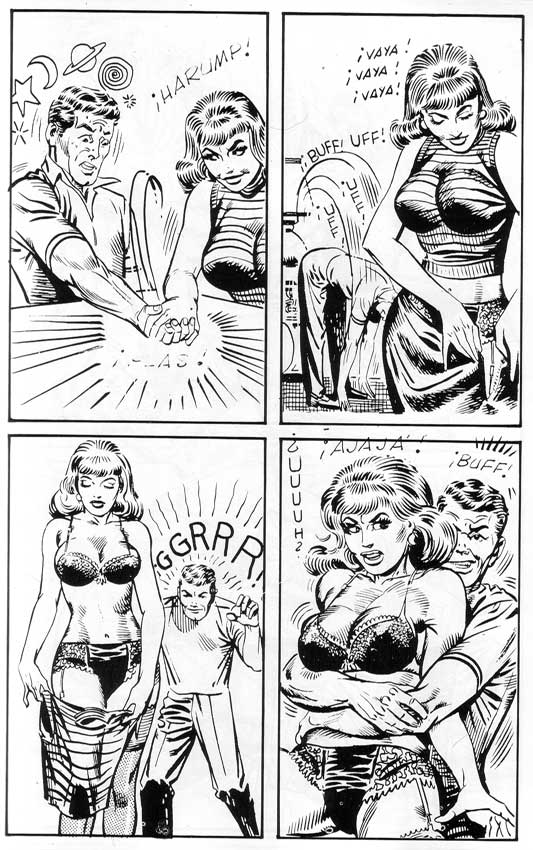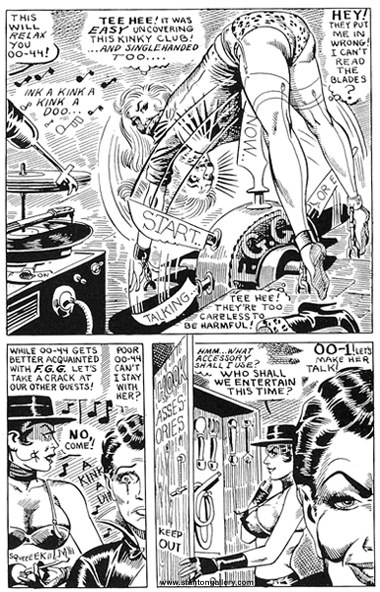The above bit of ribaldry may disconcert certain comics fans. Its style of drawing evokes that of Steve Ditko, the creator of Spider-Man and of Dr Strange — wholesome comic-book superheroes for kids. Is there a secret side of Sturdy Steve we don’t know about?
Yes and no.
Ditko attended the School of Visual Arts in Manhattan, where he made friends with another budding cartoonist, Eric Stanton (1926– 1999). He and Ditko shared a studio on 8th Avenue from 1958 to 1966.
Stanton had a specialty, though — kinky sado-maso bondage comics– his “stantoons”. Legal dynamite in the ’50s, they look oddly innocent in our current porn-saturated times.
Steve Ditko, at the same period
The two cartoonists had superficially similar styles, and were given to helping each other out with deadlines. So the above strip has, at the least, Ditko inks in the equation; the next one seems to have been laid out by him, as well.
Ditko never made a secret of his association with Stanton. With his reputation as a stern moralist, though, he seems open to a charge of hypocrisy.
But Ditko is a conservative of the Libertarian kind, and as such would have a keep-the-damn-government-out-of-the-bedroom attitude.

As for Stanton’s assists to Ditko, it’s long been rumored that he’d contributed to the first Spider-Man story. Stanton does claim to have come up with the idea of webs shooting from the character’s hands. When asked by Greg Theakston about the extent of his contribution to Spider-Man, Stanton replied:
“Almost nil…. I think I added the business about the webs coming out of his hands.”
He elsewhere makes the intriguing claim, though, that he helped Ditko out with “storyboards”.
By that word, did he mean storyboards in the usual sense — for TV or movies? New York was, and remains, a major center for the audiovisual industry, and certainly many cartoonists based in the area, such as Lou Fine and Bill Everett, produced storyboards for TV advertising. Ditko and Stanton might well have done a job or two for the screen.
Or did he use the term “storyboards” to mean comic book layouts? Ditko, at the time, was an astonishingly productive artist, not just for Marvel but also for Charlton and Warren comics. And he certainly wasn’t averse to artistic collaboration: he was sometimes inked by Dick Ayers or Mike Esposito, among others, and he himself often inked Jack Kirby ( a wonderfully quirky pairing.)
Here’s a casual claim by Stanton that seems plausible, in connection with a bondage comic:
“I made ‘Sweeter Gwen’ from John Willie’s ‘Gwendoline.’ I roughed out (penciled) 30 pages and took them over to Burtman and he said ‘great … but then I got another commission and I had to stop on ‘Sweeter Gwen.’ I asked Steve Ditko to ink it for me and we’d split the money 50% / 50%. So then we story boarded like we used to do for Spider-Man. We gave ideas to each other. We came up with a very beautiful story and we finished it and took it over….”
We’ll never know for sure. Stanton is dead, and Ditko is famously adamant in refusing to speak about his career.
Why did the pair break up? According to Stanton’s daughter Amber, her father announced to Ditko he was getting married. Ditko took this as a betrayal of Stanton’s principles… and the partnership, and friendship, were over.
One last sample, and you be the judge: how much is Stanton’s, and how much — if any– is Ditko’s?
(Nota Bene: the comics in this post were researched for reasons of scholarship ONLY.)







